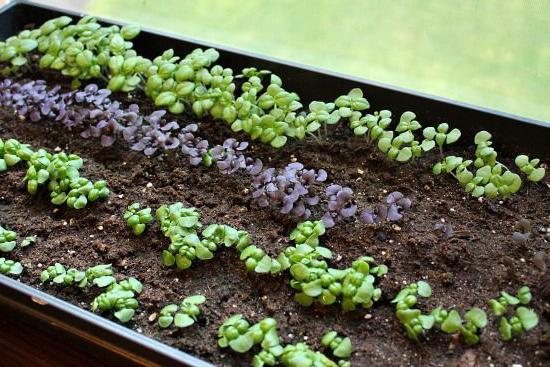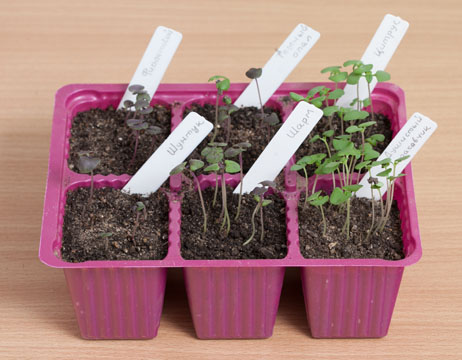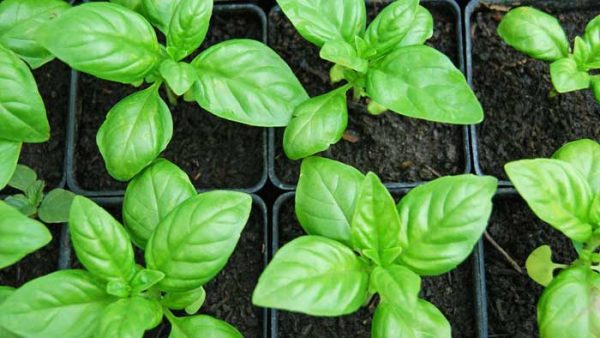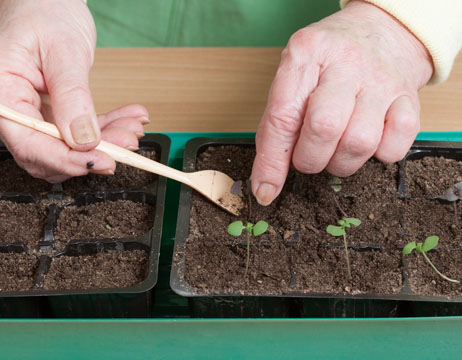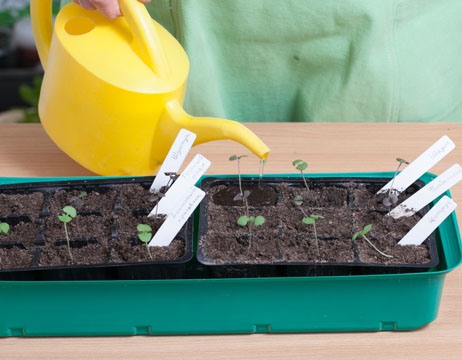Homemade basil: growing from seeds for seedlings according to all the rules
Content
How to grow seedlings from seeds
One of the main steps is planting basil seeds for seedlings. The future harvest depends on how correctly this process is carried out. In this case, containers are used in the form of containers up to 7 centimeters deep with holes for water drainage. Since the plant does not like waterlogged soil, a drainage layer of expanded clay, pieces of foam or small pebbles is laid on the bottom of the containers.
Seedlings are planted in the ground from a mixture of 4 parts of peat, 1 part of washed clean sand and 2 parts of good humus. In order not to have problems with growing seedlings in the future, the mixture must be sieved and steamed for an hour for disinfection. In the event that purchased soil purchased in a special store is used, it is treated with "Fitosporin" or a solution of potassium permanganate.
Before sowing, the seeds are pretreated by soaking them in sodium humate or growth stimulants such as Albit or Zircon. Then they are laid out on the soil surface at a distance of 5 centimeters from each other and 10 centimeters between rows and covered from above with a layer of earth about a centimeter thick. After that, the sowing is watered, covered with glass or transparent film and placed in a sunny place where the temperature is kept in the range of +23 - + 27 ° С. Further care of the basil seedlings includes regular airing and spraying.
According to the lunar calendar of gardeners, sowing can start in 2021 on days 13-19 and 21-23 in January, or 9-15, as well as 18 and 19 in February. In the spring of 2021, in March, both days from 10 to 13, and 16, 17, 20 and 21 days are favorable. In April, plant seedlings The lunar calendar recommends the 8th, 9th, 12th, 13th, 17th and 18th, in May the best days for this are 7, 10, 11 and from 17 to 19. But in the summer of 2021 for seeds the ideal days to plant them in the ground are 7, 8 and the period from 14 to 18. Experts have bred many varieties and hybrids of basil. To grow a crop at home, it is best to choose varieties with small leaves such as Clove scent, Troll, Marquis, Dwarf, Basilisk. Since sowing at the same time does not depend on the season, then choosing the best days for this in 2021, you should focus on the growing moon when it is in the signs of Scorpio, Pisces or Cancer.
One to two weeks after planting the seeds, seedlings will appear. Then the transparent cover should be removed, and the temperature should be lowered to +17 - + 20 ° C, which will help to avoid pulling the plants up. Also, for better tillering, after the appearance of 4–5 leaves, you can pinch the tops of the sprouts. At this time, they are also picked into separate pots.
Basil should be dived to stab the plants before planting them in open ground. In this case, the pots are subsequently aged in the greenhouse.In the event that the cultivation of plants will be carried out in the house, the pots should be placed on a well-lit windowsill. According to the recommendations of the Lunar Calendar 2021, plants should not be transplanted in the 12 hour period before or after the onset of the full moon or new moon.
Video "Common mistakes"
Demonstration video with useful information on mistakes when propagating spicy greens.
What is grafting for?
If you do not want to sow the seeds, and then wait for the shoots and spend the effort to grow the plants before the harvesting stage, you can use the faster method of cuttings. Since basil takes root quite well, a fresh bush bought in the supermarket or purchased on the market is quite enough.
In this case, cuttings about 8 centimeters in size are cut from the side shoots or tops. The leaves located below should be torn off, and an oblique cut should be made on the stem. After that, the cuttings are placed in a container with water, where roots will appear after a week. So that moisture from the leaves evaporates less and the plants take root faster, the container can be covered with a plastic bag.
After another 7-10 days, the rooted shoots should be planted in dedicated pots with the appropriate soil nutrient composition and placed in a sunny place. Growing by this method allows you to cut the first crop after 25-30 days. The bush obtained in this way is capable of producing fragrant and juicy leaves for the preparation of various dishes within 3-4 months. Thus, grafting makes it possible to have a fresh spice at your disposal without much hassle at any time throughout 2021. At the same time, regular pruning of bushes will allow you to form beautiful plants that will also decorate a window sill or terrace.
Further care for the basil
Further cultivation of basil will not require much trouble. After the plants take root in a new place and form a strong root system, their rapid growth will begin. When the shoots reach a height of about 15–20 centimeters, they begin to trim them, cutting off the buds and small leaves, from which these buds can form over time. This procedure should be carried out every three weeks.
During growth, the leaves exude a specific spicy aroma, which disappears when the flowering stage begins. At the same time, the leaves themselves decrease in size and become drier. Therefore, the cultivation of a spicy plant requires regular removal of the inflorescences that have appeared. In this case, the bushes will actively grow in breadth and give more fresh young leaves.
Since, according to forecasts, the summer in 2021 will be quite hot, in order to grow healthy and strong bushes, planting in the garden will need to be regularly watered in the morning hours. Moreover, it is important not to allow waterlogging, which can lead to the appearance of such a fungal disease as fusarium. Growing basil at home in the autumn-winter period requires the use of additional lighting with fluorescent lamps. Only in the case of such an artificial lengthening of daylight hours will the plant be able to grow normally and develop correctly.
What to do with the seedlings next
After transplanting the seedlings into pots, when the plants reach a height of about 5 centimeters, the soil should be loosened and then this procedure should be done regularly after 2-3 days. It is also necessary to feed the sprouts with water-soluble fertilizers containing humus. This plant loves humid air, so frequent spraying will be very useful. Watering should be done in the morning. Also, it will not be superfluous to organize additional illumination with electric lamps in order to increase the daylight hours to 8 hours.A week before the seedlings are planned to be planted in open ground, watering is limited and ventilation is organized in the greenhouse to reduce the air temperature to carry out the stabbing of the plants.
Only when the threat of night frosts has finally passed, the seedlings can be planted in open ground. Therefore, when planning sowing, you need to familiarize yourself with the long-term weather forecast for a specific area for 2021 and take into account that the moment the seeds enter the soil from the planting of shoots in the garden bed will be separated by a period of 40-50 days. The soil in the beds should be prepared in the fall by digging it well to a depth of 25 centimeters and fertilizing, adding about 4 kg of compost or humus, 15 grams of potassium salt and about 23 grams of superphosphate per square meter. It is best that the precursors of basil on the site were cucumbers or tomatoes, legumes, potatoes.
In order not to have any trouble and to grow healthy and well-developed plants, it is necessary for reliability to wait until the meteorologists in 2021 promise the onset of a period with night temperatures not lower than + 15 ° С. Basil should be planted in beds that are sheltered from the wind, but well heated. He prefers light sandy soils, which are enriched with organic matter. In the beds, plants are planted every 25 centimeters, and a distance of about 30 centimeters between the rows recedes. Planting holes should not be deeper than 8 centimeters. The central bud must remain on the surface along with young leaves.
Video "Reproduction of greenery"
Informational video with examples of green propagation.

